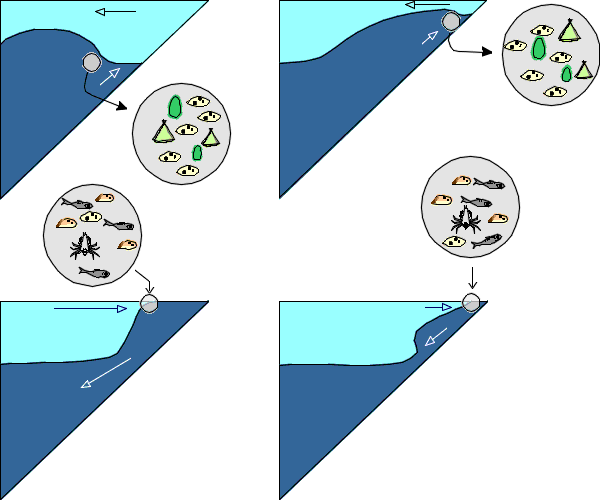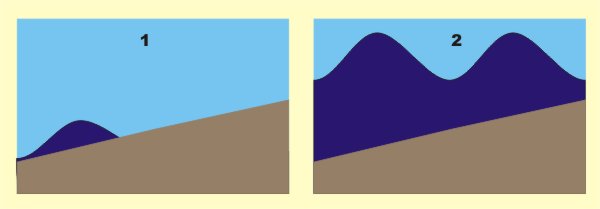|
|
Larval transport by internal bores and waves
| The problem of larval transport
by internal tidal bores has multiple facets, and the
phenomena involved occur at a variety of temporal and
spatial scales, from the fine-scales of larval accumulation
at propagating fronts, to the large-scale geophysical
modulation of the internal bores. In this page we describe
two different aspects. |
The two-way transport of larvae
by
internal tidal bores hypothesis |
- The advection of masses of water by
the internal tidal bores (dark blue bodies inside
triangles) transports onshore larvae associated to the
thermocline or living close to the sea-floor (upper
panels) (Pineda, 1991; Leichter et al.,
1998).
- The cold water pushes the warm
water offshore, creating a front that can be found up
to at least 2 km from the shore.
- As the cold water sinks
because of gravity, the currents reverse direction and
now the warm water travels shoreward at the surface,
and offshore at the bottom. The front dividing cold
and warm water concentrates and transports neustonic
larvae (lower panels). (Pineda, 1994, J. mar.
Res.; 1999 Limn. & Ocean.)
Click here for an internal-bore warm-water front
(~55 kB file).
|
 |
© Jesus Pineda. All rights reserved.
See also here
for neat internal waves of elevation
|
Low-frequency modulation and spatial variablity of the process |
The temporal modulation might involve processes with
fortnightly periodicity, but these processes are currently unknown. On the
other hand, there is strong evidence that coastally trapped waves
associated with changes in the wind field modulate the internal bores. We
believe that this process occurs as follows (Pineda and Lopez, 2002).
- The internal tide is common in coastal, relatively
deep waters.When the thermocline is deep, if is far from the shore, and
in these cases the internal tide is not observed near the shore.
That is, when the thermocline is deep, the internal tide does not
influence the near shore environment nor the bores transport larvae to
the shore
- As coastally trapped waves propagate poleward, they produce a small
change in sea-level, with a corresponding change in thermocline depth,
but of much larger vertical scale. When the sea level drops a few cm,
the thermocline shallows several m, and as the thermocline shallows, the
internal tide and the internal tidal bores are observed near the shore,
and this is precisely when larval transport by internal tidal bores
occur. In summary, when the thermocline shallows,
the internal tide also shallows, and larval transport by internal bores
occurs.
|
 |
•
The hypothesis
that nearshore, shallow internal tidal bores result from the low
frequency shallowing of the thermocline states that low frequency events
raise the thermocline allowing the occurrence of the internal tidal
bores close to the surface and at the nearshore. In short, the
wave-guide moves up and, consequently, inshore
Finally, we have
found that spatial differences in stratification influence the internal
tidal bores
(See
Pineda and Lopez [2002] -pdf link-)
|
Generality of the mechanism |
Internal tidal bores are one of the three competing hypotheses
explaining shoreward transport of invertebrate larvae (but there must be
more mechanisms, of course!). Recent studies in other regions demonstrate
this mechanism to be widespread. Furthermore, this process may be key in
explaining onshore transport of nutrients and discharged pollutants. Our lab
continues to work on small and large scale aspects of larval transport by
internal tidal bores, in the field, in the lab, and with models. Larval
transport by internal tidal bores is one of the best known larval transport
mechanisms in open coastline populations.
|
|
|
|
|
|

